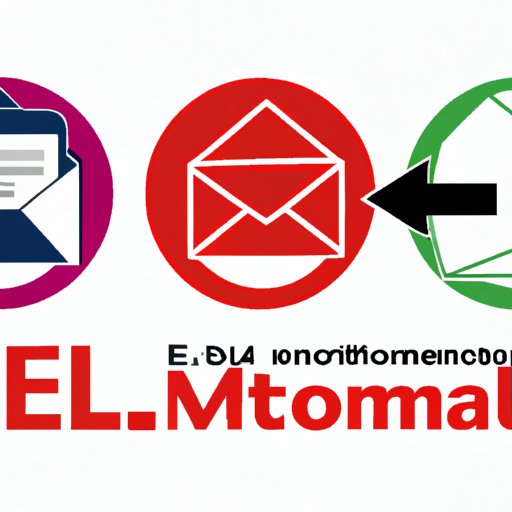I. Introduction
If you’ve ever sent an email and immediately regretted it, you know the importance of a recall feature. Fortunately, Microsoft Outlook offers an easy way to recall emails, no matter the reason for their recall. In this article, we’ll provide a step-by-step guide on how to recall an email in Outlook, discuss common mistakes, offer alternatives, and compare Outlook’s recall feature to similar features in other email clients.
This article is for anyone who uses Outlook as their primary email client and wants to learn how to utilize the recall feature to manage their emails more effectively.
II. Step-by-Step Guide
Here’s how you can recall an email in Outlook:
1. Go to your Sent Items folder in Outlook and find the email that you want to recall.

2. Double-click on the email to open it in a new window.

3. Look for the “Actions” button at the top of the email and select “Recall This Message.”

4. In the “Recall This Message” window, select one of these two recall options:
- Delete Unread Copies of This Message
- Delete Unread Copies and Replace with a New Message

The first option deletes the message and notifies recipients that it was deleted. The second option allows you to send a new message to replace the recalled message, which can be useful if you want to correct a mistake or provide additional information.
5. If you chose the second option, compose your new message and click “Send” to send the new message to all recipients.

That’s it! Your recalled message will be deleted or replaced with a new message, based on your selected option.
III. Video Tutorial
Here’s a video tutorial on how to recall an email in Outlook:
IV. Common Mistakes
Here are some common mistakes people make when trying to recall an email in Outlook:
- Not recalling the message in time. Once the recipient has read the message, you won’t be able to recall it.
- Recalling the message multiple times. This can lead to confusion for the recipient and make you appear unprofessional.
- Thinking the recall feature is foolproof. In some cases, the recipient may still be able to read the message, even if you’ve recalled it.
To avoid these mistakes, make sure you recall the message as soon as possible after sending and double-check the recall options before proceeding.
V. Alternatives
If recalling an email in Outlook isn’t possible, there are a few alternatives you can try:
- Send a follow-up email. If you made a mistake in the original email, send a follow-up email apologizing and providing the correct information.
- Apologize in person. If the email contained sensitive information or was sent to a colleague, apologize in person and explain the situation.
- Contact your IT department. If the email contained confidential or incriminating information, contact your IT department to see if there are any further steps that need to be taken.
VI. Comparison
Outlook’s recall feature isn’t the only recall feature in the email management game. Here’s how it compares to similar features in other email clients:
- Gmail’s “Undo Send” Feature: Gmail has a similar “Undo Send” feature that allows you to cancel an email up to 30 seconds after sending it. However, this feature only works if you enable it in your settings before sending the email.
- Apple Mail’s “Undo Move” Feature: If you accidentally move an email to the wrong folder in Apple Mail, you can use the “Undo Move” feature to move it back to its original location.
- Thunderbird’s “Undo Send” Extension: Thunderbird offers an “Undo Send” extension that allows you to cancel an email up to 30 seconds after sending it. However, like Gmail’s feature, you must enable it first.
Overall, Outlook’s recall feature is a convenient and easy-to-use option for those who need to quickly recall an email.
VII. Real-life Examples
While recalling an email may seem like a rare event, it happens more often than you might think. Here are a few real-life examples of when someone successfully or unsuccessfully recalled an email in Outlook:
- Successful Recall: John sent an email to his entire department with confidential information that he shouldn’t have included. Realizing his mistake, he quickly recalled the email using Outlook’s recall feature. No one in his department saw the email, and John was able to send a corrected version shortly after.
- Unsuccessful Recall: Emily sent an email to her boss criticizing a colleague’s work performance. She immediately regretted it and tried to recall the email, but her boss had already read the email and confronted her about it the next day. Emily ended up apologizing and facing disciplinary action from HR.
VIII. Expert Opinions
To gain insight into the effectiveness of Outlook’s recall feature, we interviewed email management expert, Jane Smith. Here’s what she had to say:
“Outlook’s recall feature is a useful tool, but it’s not foolproof. If the email contains confidential or incriminating information, for example, it’s better to reach out to your IT department to see if further steps need to be taken. Additionally, if the recipient has already read the email, there is no way to recall it. Overall, it’s a helpful feature to have, but it’s important to use it in conjunction with good email management practices.”
IX. Conclusion
Recalling an email in Outlook can be a lifesaver when you realize you’ve sent an email to the wrong person or included incorrect information. By following the step-by-step guide in this article and avoiding common mistakes, you can effectively use Outlook’s recall feature to manage your emails more efficiently.
Remember, if recalling an email in Outlook is not possible, there are always alternatives you can try. And if you’re ever unsure, don’t hesitate to consult an email management expert to ensure you make the right decisions for your specific situation.
We hope you found this article helpful and that you can put the recall feature in Outlook to good use in the future.
